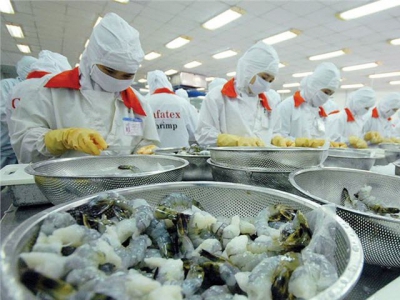China bans shrimp imports from Ecuador, an opportunity for Vietnamese shrimps?

China has banned shrimp imports from five large Ecuadorian shrimp exporters. Is this an opportunity for Vietnamese shrimps?
According to the Vietnam Association of Seafood Exporters and Producers (VASEP), in September 2019, China issued a ban on shrimp imports from five large Ecuadorian shrimp exporters due to fears of disease that may spread into its country.
After the negotiations, China allowed Omarsa Company from exporting again while the remaining four exporting companies are still banned. These four companies are currently only allowed to export cooked steamed shrimp to China.
China is Ecuador's largest shrimp import market. The five companies under China's ban account for about 40 percent of Ecuador's total shrimp export. Five years ago, China accounted for 30 percent of Ecuadorian shrimp exports (68,603 tonnes, valued at US$584 million). In 2018, this proportion increased to 61 percent, equivalent to 281,718 tonnes. Ecuador is also the largest shrimp supplier to China, accounting for 40 percent of China's total shrimp imports. Vietnam is the fifth biggest supplier, accounting for 4.8 percent.
In the first eight months of this year, Ecuadorian shrimp exports to China reached 210,000 tonnes, worth more than $1 billion, a sharp increase over the same period last year but the ban. But the ban makes Ecuadorian shrimp exports to China declined in September.
China is also one of the major export markets for Vietnamese shrimp processing enterprises, which is now Vietnam’s fifth largest exporting market. The fact is that China’s ban may create an opportunity for Vietnam’s shrimps to China
However, this opportunity will not last forever because the ban also will be removed sooner or later based on factors such as politics, diplomatic relations and trade between the two countries.
Looking back in recent years together with China's ban on Ecuadorian shrimps, it is clear that countries that have both raised shrimp and imported shrimp such as Australia, South Korea and China must closely examine disease in imported shrimps to ensure domestic production.
Therefore, according to VASEP, Vietnam's shrimp industry and shrimp enterprises need to see clearly challenges from China’s ban on Ecuadorian shrimp imports. Firstly, we cannot foresee when the ban will be removed. If Vietnamese enterprises rush to export shrimp to this market, Vietnamese enterprises may be passive when the situation changes, leading to price pressure and lower prices.
Secondly, it is possible that after Ecuador, it will be India, Vietnam or other shrimp producing countries. Therefore, we must predict this possibility and prepare for strengthening disease inspection of shrimp import markets such as Australia, South Korea and China and other markets. And it will not only test for yellowhead disease, white spot disease in shrimp but also other diseases such as MBV (stunting disease caused by shrimp infected with MBV virus), red tail disease or Taura syndrome, necrosis in shrimp ( IHHNV) .
For Vietnamese shrimp exported to China, from 2014, Vietnam and China signed an agreement on aquatic food safety control. Accordingly, China control four diseases: Yellow-headed white spot, MBV, Taura, IHHNV for black tiger shrimp and whiteleg shrimp.
However, Vietnamese shrimp producers and exporters also need to anticipate the possibility that China will have stricter inspections of diseases in shrimp exported from Vietnam. It may not only inspect live shrimp but also other types of products such as chilled, frozen shrimp.
Therefore, Vietnam’s shrimp industry needs to be proactive in controlling diseases (focusing on the environment of ponds, breeds, nutrition, etc.), ensuring the quality of food safety and disease safety in exported products not only to China market but also other markets.
According to VASEP, after many months of decline, from May 2019, China's demand for shrimp imports from Vietnam has been higher, enterprises have also caught up with market requirements and had a better adjustment, so Vietnam shrimp exports to this market has achieved positive growth. In the first eight months of 201
9, shrimp exports to China reached $336.5 million, up 5 percent over the same period last year.
VASEP forecasts exports of Vietnamese shrimp to China from now until the end of the year will maintain positive growth momentum. Enterprises should update new Chinese requirements and regulations and make adjustments to maintain exports to this market.
Related news
 Cultivated shrimp infected with Hepatopancreatic Microsporidiosis for the first time
Cultivated shrimp infected with Hepatopancreatic Microsporidiosis for the first time Many shrimps in the summer-autumn crop of HàTĩnh farms have been infected with EnterocytozoonHepatopenaei, the causative agent of Hepatopancreatic
 Price of commercial lobster increases by 200-300 thousand VND per kilogram
Price of commercial lobster increases by 200-300 thousand VND per kilogram This is the end of the 2018-2019 season for commercial lobster farming. Farmers in Nhơn Hải commune of Quy Nhơn city, Bình Định province are harvesting
 China opens market for three more kinds of Vietnamese aquatic products
China opens market for three more kinds of Vietnamese aquatic products The General Departent of China Customs has announced via a diplomatic note the agreement to supplement three kinds of Vietnamese aquatic products allowed